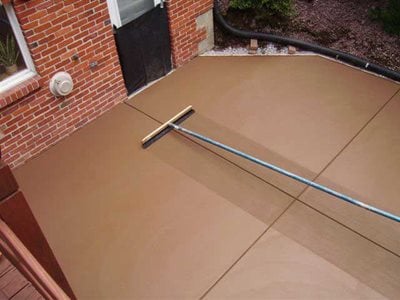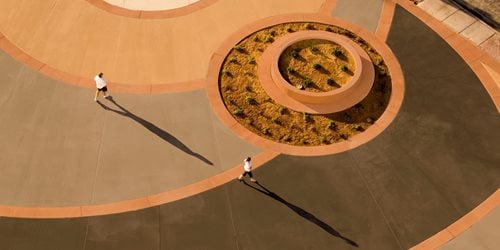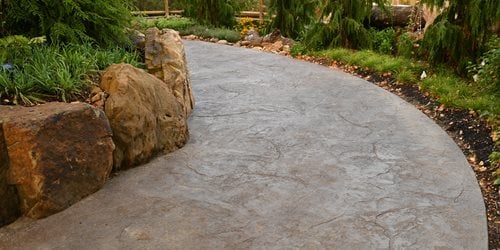Booth S11215
Get answers to your most pressing questions about colored concrete.
Posted 9/9/2025

Even for experienced contractors, coloring concrete raises lots of questions. Here, we cover everything from curing concerns to color matching and everything in between.
Yes. As it cures, newly poured concrete with integral color does go through noticeable color changes. When concrete is freshly poured, the surface appears darker because of the higher moisture content. As the concrete begins to cure and water evaporates, the color begins to lighten and even out.
It’s important to communicate closely with your clients so you can make sure they know what to expect throughout the installation process.
Sometimes concrete looks blotchy during the initial curing process but evens out in the end. However, finished concrete can stay blotchy when there are inconsistencies in the concrete mix design or finishing practices.
Here are some common causes of discoloration:
How to prevent blotchy color:
Consistency is everything. Don’t change your mix, tools, or timing midway through the job. Small changes show up big in the finished color. But, if you do end up with blotchy concrete, there are ways to even out the color later. Read more about changing concrete color.
💡 Pro Tip: On decorative projects that require multiple pours, consider using color strategically. You can break up the slab with complementary colors, or use a color hardener to ensure uniformity across large placements.
Getting an exact color match between new and old concrete is difficult due to batch-to-batch variation. Finishing quality also plays a role, and in many cases the contractor trying to match the new pour had nothing to do with the original slab. Getting details like the original mix design, water-to-cement ratio, or pigment dosage can help, but that information is often hard to track down. Even so, you can usually get close enough for a nearly seamless look.
Pay attention to these factors that have a big impact on color:

Our Color Lab can assist with getting you the perfect match. Learn more about color matching.
If you’ve already poured and it doesn’t match, don’t worry. Products like Brickform Cem-Coat can be applied over old and new concrete to create a uniform look. For slight color variations and evening out minor color issues, Refresh Stain and Sealer can help.
Liquid color, granular pigments and powdered color are all reliable ways to add color to concrete. The choice often comes down to your batching setup, the type of work you do, and how your ready-mix supplier or distributor is equipped.
Granular pigments:
Liquid pigments:
Powdered pigments:
When deciding which type to use, consider the size of your jobs, how you batch, budget, and which system your supplier supports. All three methods deliver dependable results when used correctly.
The right pigment dosage depends on three factors:
Always follow recommended dosage rates to achieve consistent results.
General guidelines:
For detailed information, see our pigment loading guide.
💡 Pro Tip: Always pour a mockup before the main pour. At minimum, make a small test slab to confirm color with your client under real conditions. If you have the space and resources, consider pouring a larger sample pad at your shop, yard, or even at home. This can showcase your work and give homeowners ideas.

Yes, the cement you use affects the final color of the concrete. A cement that is white or light gray will help the true tone of your pigment show, which is best when you’re aiming for vibrant colors. Gray cement, on the other hand, gives you a more muted, earthy version of the same color.
Sand and aggregate also make a difference. Sand can vary in shade and texture depending on the source, and different aggregates will influence the final look. Remember, pigment only colors the cement paste, not the sand or stone. If you’re using a product like Select-Etch to expose the top surface, the aggregate will show through with its own natural color.
The only way to achieve uniform color is to keep your mix design consistent: same cement source or ready-mix plant, same sand, same aggregates, same admixtures, and the same water-to-cement ratio across the job. Even weather conditions and finishing techniques can affect the outcome.
💡 Pro Tip: Good communication with your ready-mix supplier is key. Build a relationship with a respectable provider and keep them in the loop about your color needs. The more consistent your supplier is with materials, the more consistent your finished color will be.
Yes, admixtures such as water reducers or accelerators can be used with pigment. The exception is calcium chloride accelerators, which should be avoided because they cause discoloration. If you need to speed things up, use a nonchloride accelerator such as hot water instead.
Keep in mind that admixtures can change the water-to-cement ratio, setting time, and curing conditions. These changes may lead to subtle shifts in color shade. For that reason, it’s always best to pour a test slab before starting a large project.
💡 Pro Tip: If you’re using accelerators, be ready to move fast. Start finishing or stamping as soon as the slab starts setting, because once the mix takes off it can get away from you quick. Know your mix and avoid adding water to slow things down.
No. Adding water on site while you’re finishing colored concrete can cause unintended color variations. Extra water may lighten or fade the surface, and if it puddles in some areas and not others, you’ll end up with blotchy spots. Even worse, putting water on the slab can lead to spalling, plastic shrinkage cracking, or popouts.
A better alternative is to use a finishing aid such as Brickform’s DAY1. It lubricates the surface and eliminates the need for water sprays, giving you a smoother finish and a more consistent color.
We don’t recommend covering colored concrete with plastic sheeting during curing. Plastic traps moisture unevenly, which often leads to dark spots and blotchy color.
Instead, use breathable materials such as burlap or curing blankets. These allow moisture to escape while still protecting the surface from dust, leaves, and other debris.
If rain is in the forecast, you can use plastic temporarily, but remove it as soon as possible to avoid blotchy spots. Curing compounds are another option, but some products may slightly change the color or surface appearance. Always test first and make sure the curing method you choose is compatible with integral color.
Yes, the type of sealer you use can change the appearance of colored concrete. Many sealers will enhance the color, and most add a surface sheen that can range from low matte to high gloss. With a film-forming sealer, the color can darken to about the same shade as when the concrete is wet. An easy way to preview this is to hose down the slab. What you see wet is close to what you’ll get with a film-forming sealer.
💡 Pro Tip: Set client expectations before sealing. Show them a test area or sample slab with sealer applied so they know how the final sheen and color depth will look.
If you want to preserve the natural color as much as possible, choose a natural-look sealer such as Stealth-Seal. It's virtually invisible while sealing the pores of the concrete. It waterproofs and repels oil, water, and other debris without changing the color or sheen.

Everything you need to know about adding color to concrete—from selection to installation and maintenance

Find out how to choose the right stamped concrete color for any job

Color variation, blotchy finishes, and customer complaints often stem from a few avoidable mistakes. The key to success is consistency.
Explore impressive concrete installations to find inspiration for your next project.
Find out how much color and fiber you'll need for any size project.